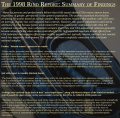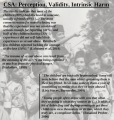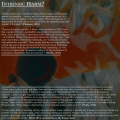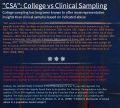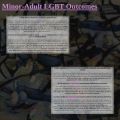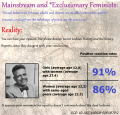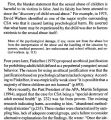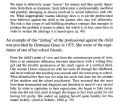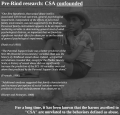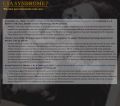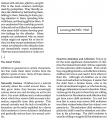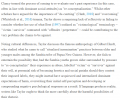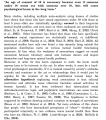One of our staff members is contributing considerably to a News Archiving service at Mu. Any well educated (Masters, PhD or above) users who wish to make comments on news sites, please contact Jim Burton directly rather than using this list, and we can work on maximising view count.
Research: Secondary Harm: Difference between revisions
No edit summary |
The Admins (talk | contribs) |
||
| Line 83: | Line 83: | ||
===Self-appraisal of abuse=== | ===Self-appraisal of abuse=== | ||
Even in studies where nonconsent/unwillingness is prerequisite, varying portions of the samples to dot perceive themselves as having been sexually abused. Absent the perception of abuse, outcomes tend to be markedly better. | |||
*'''[[Richard McNally|McNally, Richard J.]], and Geraerts, Elke (2009). "A New Solution to the Recovered Memory Debate," ''Perspectives on Psychological Science'', 4(2), 126-134.''' | *'''[[Richard McNally|McNally, Richard J.]], and Geraerts, Elke (2009). "A New Solution to the Recovered Memory Debate," ''Perspectives on Psychological Science'', 4(2), 126-134.''' | ||
| Line 89: | Line 91: | ||
*'''Holmes, W. C. (2008). "[http://www.ipce.info/library_3/pdf/holmes_self-def.pdf Men's self-definitions of abusive childhood sexual experiences, and potentially related risky behavioral and psychiatric outcomes]," ''Child Abuse & Neglect'', 32, 83–97.''' | *'''Holmes, W. C. (2008). "[http://www.ipce.info/library_3/pdf/holmes_self-def.pdf Men's self-definitions of abusive childhood sexual experiences, and potentially related risky behavioral and psychiatric outcomes]," ''Child Abuse & Neglect'', 32, 83–97.''' | ||
*:"Emerging data not only suggest (1) that not all men with abusive CSEs [child sexual experiences] cognitively appraise their abusive CSEs to have been CSA, but also (2) that the cognitive appraisal of abusive CSEs as CSA or not appears to drive whether CSA is associated with poor outcomes (Carballo-Dieguez & Dolezal, 1995; Fondacaro et al., 1999; Stander, Olson, & Merrill, 2002; Stanley, Bartholomew, & Oram, 2004; Steever, Follette, & Naugle, 2001)." | *:"Emerging data not only suggest (1) that not all men with abusive CSEs [child sexual experiences] cognitively appraise their abusive CSEs to have been CSA, but also (2) that the cognitive appraisal of abusive CSEs as CSA or not appears to drive whether CSA is associated with poor outcomes (Carballo-Dieguez & Dolezal, 1995; Fondacaro et al., 1999; Stander, Olson, & Merrill, 2002; Stanley, Bartholomew, & Oram, 2004; Steever, Follette, & Naugle, 2001)." | ||
*'''Linde-Krieger, L et al (2020). "[https://adlab.ucr.edu/wp-content/uploads/2020/11/Linde-Krieger-Moon-Yates-2020-The-Implications-of-Self-Definitions-of-Child-Sexual-Abuse-for-Understanding-Socioemotional-Adaptation-in-Young-Adulthood.pdf he Implications of Self-Definitions of Child Sexual Abuse for Understanding Socioemotional Adaptation in Young Adulthood]," ''Journal of Child Sexual Abuse'', 30:1, 80-101.''' | |||
*:"Relative to their nonmaltreated peers, survivors with concordant abuse perceptions evidenced the largest elevations in psychopathology and risk behaviors, whereas survivors with discordant abuse perceptions evidenced the largest deficits in self-system functioning. These findings indicate that standard screening criteria may misidentify a sizable group of CSA survivors because these individuals do not perceive their experiences as "abuse."" | |||
===Earlier research=== | ===Earlier research=== | ||
Revision as of 09:17, 21 November 2021
Secondary harm may occur when a childhood sexual experience is reinterpreted as abusive, or when police or parents intervene in an intergenerational relationship.
Evidence that secondary harm occurs
Stigma as a factor
- Bauserman, Robert; Rind, Bruce (1997). "Psychological Correlates of Male Child and Adolescent Sexual Experiences with Adults: A Review of the Nonclinical Literature," Archives of Sexual Behavior, 26(2), 105-141.
- "Secondary consequences include reactions of others, such as parents and peers, to the sexual contacts. Feelings of guilt and shame regarding the sexual contacts, which are based on perceived violation of one’s own and others’ norms, are also addressed here.
- Emotional responses of guilt were related to outcomes, with greater guilt associated with more negative responses, Haugaard and Emery (1989) and Okami (1991) both reported guilt feelings to be associated with negative evaluations of experiences. Stein et al. (1988), in their study of unwanted experience in a community sample, noted that feelings of guilt and shame were common. Risin and Koss (1987) reported that guilt feelings were more common in experiences involving fondling, which were also associated with more force and greater levels of other negative feelings. Finally, Sandfort (1984) reported that when the boys interviewed in his study were asked about negative aspects of their relationships, many cited concerns about possible negative reactions from others, such as parents, peers, and authorities.
 | ||||||||||||
| Part of NewgonWiki's research project | ||||||||||||
|---|---|---|---|---|---|---|---|---|---|---|---|---|
|
| ||||||||||||
| ||||||||||||
|
| ||||||||||||
| Template: Research - This template |
- The role of socialization in these reactions may be very important. Finkelhor (1979) and Fritz et al. (1981) both suggested that boys’ reactions may be more positive than those of girls because boys are socialized to regard sex in a more positive fashion, whereas girls receive more negative messages. Fritz et at. (1981) stated that although girls typically regarded their experiences as sexual violation, boys often regarded their experiences as sexual initiation.
- Clearly, feelings of guilt and shame and concerns about negative reactions from others are associated with negative responses to early sexual contacts with adults. These responses, however, are not inherent in the sexual contact per se but rather stem from social taboos and condemnation (cf. Constantine, 1981). To the extent that boys receive more positive messages regarding sexuality, they are less likely to experience these negative emotions and to react negatively to sexual contacts."
- Nelson, Joan A. (1986). "Incest: Self-Report Findings From a Nonclinical Sample," Journal of Sex Research, 22(4), 473-474.
- "No force of any kind was found in 49% (68) of the reports. Yet 30% (14) of these no-force experiences were described as negative. The individuals described their otherwise consensual experiences as affected negatively by guilt or fear of social or parental disapproval, an issue which emerged repeatedly in the interviews and written responses, both positive and negative. Approximately half of the female respondents and 4% of the male respondents stated that they continued to experience conflict in regard to their incest experiences, usually associated with, if not a direct result of, guilt, even though many of the relationships had terminated many years before the report. One respondent commented, "I went crazy trying to understand how anything so good could be so bad.""
- Higgins, D. J., & McCabe, M. P. (2003). "Maltreatment and Family Dysfunction in Childhood and the Subsequent Adjustment of Children and Adults," Journal of Family Violence, 18(2)
- Three co-published studies. In Study 1, "Parental sexual punitiveness, traditionality, family adaptability and family cohesion significantly predicted scores on 4 maltreatment scales and children's externalizing behavior problems." In Study 2, "Parental sexual punitiveness, traditionality, family adaptability, and family cohesion during childhood predicted the level of maltreatment and current psychopathology."
- Coffey, P., Leitenberg, H., Henning, K., Turner, T., & Bennett, R. T. (1996). "Mediators of the long-term impact of child sexual abuse: Perceived stigma, betrayal, powerlessness, and self-blame," Child Abuse & Neglect, 20(5), pp.447-455
- "Regression analyses entering only the level of sexual activity to predict the mediator variables found that level of sexual activity was related to stigma [...] The level of sexual activity was also a direct predictor o1 the GSI when entered into a regression as the sole predictor [...] However, when level of sexual activity and the mediator variables were used in combination to predict GSI, this analysis yielded an X2 of .33, F(5,168) = 16.71, p < .0000 and the only predictors that accounted for unique variance in the GSI were two of the mediators. They were stigma (B = .36), F = 17.04, p < .001 and self-blame (B = .25), F = 11.99, p < .0007. The level of sexual activity was no longer a significant predictor of the GSI score when the mediators were entered into the equation. The results of this path analysis therefore indicate that the only mediational paths in predicting adjustment on the GSI were for level of sexual activity via stigma and self-blame. [...] Because the path analysis tests a particular mediation model it is also fair to say that these results support the hypothesis that stigma and self-blame may underlie the long-term negative impact of a child sexual abuse experience. [...] Clearly feelings of self-blame and stigma regarding child sexual abuse can linger long into adulthood. This sense of feeling ashamed, tainted, and blameworthy regarding the abuse may impact adjustment by affecting the survivor's core beliefs about their worth as a person. Struggling with these feelings may result in heightened levels of psychological distress. These findings further suggest that feelings of both stigma and serf-blame in adulthood are particularly affected by the level of sexual activity involved in the abusive experience. It may be that higher levels of sexual activity result in an increased sense of being "damaged goods" and tainted due to a greater sense of personal and societal violation. Certainly society considers intercourse to be the most taboo form of sexual contact with children."
- Finkelhor, D. & Browne, A. (1985). "The traumatic impact of child sexual abuse: A conceptualization," American Journal of Orthopsychiatry, 55 (4), 530-541.
- Three of the four "tramagenic dynamics" proposed by Finkelhor for child sexual abuse are related to Western society's conceptualization of sex or reaction to CSA. "Betrayal refers to the dynamic by which children discover that someone on whom they were vitally dependent has caused them harm. This may occur in a variety of ways in a molestation experience. For example, in the course of abuse or its aftermath, children may come to the realization that a trusted person has manipulated them through lies or misrepresentations about moral standards. They may also come to realize that someone whom they loved or whose affection was important to them treated them with callous disregard. [...] A child who was suspicious of a father’s activities from the beginning may feel less betrayed than one who initially experienced the contact as nurturing and loving and then is suddenly shocked to realize what is really happening. Obviously, the degree of betrayal is also related to a family’s response to disclosure. Children who are disbelieved, blamed, or ostracized undoubtedly experience a greater sense of betrayal than those who are supported. [...] Powerlessness – or what might also be called disempowerment, the dynamic of rendering the victim powerless – refers to the process in which the child’s will, desires, and sense of efficacy are continually contravened. [...] But force and threat are not necessary; any kind of situation in which a child feels trapped, if only by the realization of the consequences of disclosure, can create a sense of powerlessness. [...] Stigmatization, the final dynamic, refers to the negative connotations (e.g., badness, shame, and guilt) that are communicated to the child around the experiences and that then become incorporated into the child’s self-image. These negative meanings are communicated in many ways. They can come directly from the abuser, who may blame the victim for the activity, demean the victim, or furtively convey a sense of shame about the behavior. Pressure for secrecy from the offender can also convey powerful messages of shame and guilt. But stigmatization is also reinforced by attitudes that the victim infers or hears from other persons in the family or community. Stigmatization may thus grow out of the child’s prior knowledge or sense that the activity is considered deviant and taboo, and it is certainly reinforced if, after disclosure, people react with shock or hysteria, or blame the child for what has transpired. Children may be additionally stigmatized by people in their environment who now impute other negative characteristics to the victim (e.g., loose morals or “spoiled goods”) as a result of the molestation. [...] Some children may be too young to have much awareness of social attitudes and thus experience little stigmatization, whereas others have to deal with powerful religious and cultural taboos in addition to the usual stigma." The single non-related dynamic ("traumatic sexualization") explains responses that are considered negative because of Western society's conceptualization of sex.
- Malón, Agustín (2009). "Onanism and Child Sexual Abuse: A Comparative Study of Two Hypotheses ," Archives of Sexual Behavior. In press.
- This article agrees with the above analysis of Finkelhor's model: "Finkelhor and Browne (1985) hypothesized four “traumatogenic dynamics”: traumatic sexualization, deceit, defenselessness, and stigmatization, and claimed these explained the traumatic specificity of CSA, something that is different from other otherwise equally severe trauma. But even a cursory examination of these shows they are found in other than CSA experiences, all are not always present, nor are they necessarily intrinsic to the child’s experience; they are, in fact, largely extrinsic societal artifacts."
- Malón, Agustín (2009). "Onanism and Child Sexual Abuse: A Comparative Study of Two Hypotheses ," Archives of Sexual Behavior. In press.
- Three of the four "tramagenic dynamics" proposed by Finkelhor for child sexual abuse are related to Western society's conceptualization of sex or reaction to CSA. "Betrayal refers to the dynamic by which children discover that someone on whom they were vitally dependent has caused them harm. This may occur in a variety of ways in a molestation experience. For example, in the course of abuse or its aftermath, children may come to the realization that a trusted person has manipulated them through lies or misrepresentations about moral standards. They may also come to realize that someone whom they loved or whose affection was important to them treated them with callous disregard. [...] A child who was suspicious of a father’s activities from the beginning may feel less betrayed than one who initially experienced the contact as nurturing and loving and then is suddenly shocked to realize what is really happening. Obviously, the degree of betrayal is also related to a family’s response to disclosure. Children who are disbelieved, blamed, or ostracized undoubtedly experience a greater sense of betrayal than those who are supported. [...] Powerlessness – or what might also be called disempowerment, the dynamic of rendering the victim powerless – refers to the process in which the child’s will, desires, and sense of efficacy are continually contravened. [...] But force and threat are not necessary; any kind of situation in which a child feels trapped, if only by the realization of the consequences of disclosure, can create a sense of powerlessness. [...] Stigmatization, the final dynamic, refers to the negative connotations (e.g., badness, shame, and guilt) that are communicated to the child around the experiences and that then become incorporated into the child’s self-image. These negative meanings are communicated in many ways. They can come directly from the abuser, who may blame the victim for the activity, demean the victim, or furtively convey a sense of shame about the behavior. Pressure for secrecy from the offender can also convey powerful messages of shame and guilt. But stigmatization is also reinforced by attitudes that the victim infers or hears from other persons in the family or community. Stigmatization may thus grow out of the child’s prior knowledge or sense that the activity is considered deviant and taboo, and it is certainly reinforced if, after disclosure, people react with shock or hysteria, or blame the child for what has transpired. Children may be additionally stigmatized by people in their environment who now impute other negative characteristics to the victim (e.g., loose morals or “spoiled goods”) as a result of the molestation. [...] Some children may be too young to have much awareness of social attitudes and thus experience little stigmatization, whereas others have to deal with powerful religious and cultural taboos in addition to the usual stigma." The single non-related dynamic ("traumatic sexualization") explains responses that are considered negative because of Western society's conceptualization of sex.
Intervention and reactions
- Plummer, Ken (1981). "The Paedophile's Progress: A View from Below," in Brian Taylor (ed.), Perspectives on Paedophilia, p. 227. London: Batsford.
- "Studies point to the experience being without trauma and frequently mutually pleasurable ... unless, and this is an important proviso, it is 'discovered' by the family or the community. When this happens, it appears that the child can become shocked by the engulfing anger and outrage of the adult."
- Henry, J. (1997). "System intervention trauma to child sexual abuse victims following disclosure," Journal of Interpersonal Violence, 12(4), 499-512.
- "Results indicated that higher trauma scores, as measured by the Trauma Symptom Checklist, were related to an increased number of interviews, even when other aspects of the abuse such as seriousness were controlled for." (As cited in Investigation & Prosecution in Child Sexual Abuse)
- Berliner, L., & Conte, J. R. (1995). "The effects of disclosure and intervention on sexually abused children," Child Abuse and Neglect, 19(3), 371-384.
- "Having contact with a greater number of professionals following disclosure was related to greater negative impact of the abuse." (As cited in Investigation & Prosecution in Child Sexual Abuse)
- Sandfort, T. (1987). Boys on their contacts with men: A study of sexually expressed friendships, New York: Global Academic Publishers, 1987.
- "Great stress is placed in the literature upon the reaction of the child's environment if it comes to light that he has had sex with an adult. According to Weeks (1976) parental response is the single most important factor in determining what effect this will all have upon the child (See also Zeegers 1968, Van der Kwast 1975). Also if the discovery results in a court case this can turn the sexual contact into a negative experience." (Chapter 3)
- Storr, A. (1974). Sexual Deviation, Penguin, Harmondsworth, p.105.
- "various authorities who have examined children who have been seduced have concluded that the emotional as opposed to the physical damage which is done to children is more the result of adult horror than of anything intrinsically dreadful in the sexual contact itself"
- Jones, G. (1990). "The Study of Intergenerational Intimacy in North America: Beyond Politics and Pedophilia," Journal of Homosexuality, 20(1-2), pp. 275-295.
- "Such harm undoubtedly can occur, though a number of authors have pointed out that the trauma may be induced or exacerbated by strong reactions of parents, police,court officials and other adults when they discover that such an activity has taken place (Lempp, 1978; Mohr, 1968; Weeks, 1976)."
- Forouzan, Elham, and Gijseghem, Hubert Van (2005). "Psychosocial Adjustment and Psychopathology of Men Sexually Abused During Childhood," International Journal of Offender Therapy and Comparative Criminology, 49(6), 626-651
- "However, it has also been reported that invasive interventions could be just as harmful as the absence of family and structured support to the victim’s development (Elwell & Ephross, 1987; Van Gijseghem, 1998)."
- O'Carroll, Tom (2000). "Sexual Privacy for Paedophiles and Children: A Complementary Background Paper."
- "Regarding iatrogenic sources of harm, Prof Richard Green has written: "…research suggests that cases leading to official legal action -- rather than being dealt with informally -- produce more severe and lasting ill effects on children." Green cites several studies, the first American (Walters, 1975): "Most of the psychological damage, if any, stems not from the abuse but the interpretation of the abuse and the handling of the situation by parents, medical personnel, law enforcement and school officials, and social workers." An English study (Howard League Working Party, 1985), found: "The degree of lasting harm suffered by victims… seems to flow predominantly not from the sexual nature of the experience, but rather from other sources of shock associated with it, notably the use of violence or intimidation or the abuse of parental powers. The subsequent intervention of parents, or other authorities, in order to bring the offender to justice often seems to aggravate the damage caused by the offence itself." (Sexual Science and the Law, by Richard Green, Harvard, 1992)"
- Kilpatrick, A. (1987). "Childhood sexual experiences: Problems and issues in studying long-range effects," The Journal of Sex Research, 23, 173-196.
- "A related issue with respect to the use of terms like "consequences" and "effects" is that these terms imply causal relationships between childhood sexual experiences and adult functioning. Such causal inferences are usually inappropriate given the retrospective and/or correlational nature of many of the studies. For example, there have been many reports that the social system's handling of incidents regarding sexual abuse of children caused as much or more harm as the sexual experience itself (Brunold, 1964; De Francis, 1969; Justice & Justice, 1979; Mann & Gaynor, 1980; Schultz, 1973; Summit & Kryso, 1978). Effects or consequences attributed to the sexual experience itself may have actually been caused by the way the experience was handled by the social system, or, for that matter, by any number of other factors."
- Oellerich, Thomas D. (2001). "Child Sexual Abuse: Is the Routine Provision of Psychotherapy Warranted?," IPT Journal, 11(1).
- "Social workers should educate the community and the courts about the myths surrounding the problem of child sexual abuse. This includes laying to rest the myth that because a sexual activity violates a moral and/or a legal code that it is thereby necessarily or even usually psychologically harmful. In other words, it is time to stop equating wrongfulness with harrnfulness in sexual matters as suggested by Rind and Tromovitch (1997).
- Perpetuating the myth that sexual abuse is necessarily or usually harmful is unethical and creates possible iatrogenic effects, as noted sometime ago by Schultz (1980)
- (...)
- Social workers should educate courts to stop routinely referring the sexually abused for therapy. Child sexual abuse is not a psychiatric disorder or a syndrome (Finkelhor, & Berliner, 1995). Rather it is an event or series of events in a person's life. Treatment is indicated only when there is currently demonstrable harm. To do otherwise is similar to a physician treating children for bicycle accidents. Many children who have a bicycle accident do not require treatment. When they do need treatment, it is for a clinical condition rather than the event responsible for that condition. In other words, the asymptomatic child or adolescent should not be treated.
- (...)
- Child sexual abuse has become an arena for opportunistic therapists to exploit and revictimize victims of child sexual abuse. It is time to heed and respond to the earlier warning of Browne and Finkelhor (1986). They warned that "advocates not exaggerate or overstate the intensity or inevitability of these consequences" because "victims and their families ... may be further victimized by exaggerated claims about the effects of sexual abuse" (p. 178). Indeed, it is time that, as recommended by Seligman, parents of sexually abused children were encouraged "to turn down the volume" lest they create or aggravate a negative reaction to the abuse."
- Okami, Paul (1990). "Sociopolitical Biases in the Contemporary Scientific Literature on Adult Human Sexual Behavior with Children and Adolescents," in J. Feierman (ed.), Pedophilia: Biosocial Dimensions, pp. 91-121. As summarized on MHAMic.
- "All researchers, including victimologists, have noted the harm to children that can result from social and institutional responses to sexual abuse; that is, iatrogenic harm. Parental overreaction or lack of support, insensitive police interrogations or judicial proceedings, and social alienation can cause harm equal to or exceeding that caused by the abuse itself.
- [...] , if a minor who had a sexual relationship with an adult does not arrive at the therapist’s office feeling he was harmed, he will surely leave feeling so, because the system requires it. Patients either have positive or neutral experiences "redefined" by the therapist as negative, or they simply don’t share these experiences at all, as in the case of one patient who wrote: “My therapist is so opinionated against child molesters that she wouldn’t be able to understand if I told her I enjoyed it. I’m sure she’d kill me.”
- Policies based on inaccurate or biased information also cause iatrogenic harm to society as a whole. Many parents and caregivers are reluctant to provide the attention and affection that children and adolescents need, lest they be accused of sexual abuse."
- Dienske, H. (1990). "Function in Reference to Pedophilia and Pedosexual Behavior," in J. Feierman (ed.), Pedophilia: Biosocial Dimensions, p. 332.
- "It seems that the harm brought to the juvenile by the actual pedophilic sexual contact often can be much less evident than the harm of the process of social control [...]"
- Encyclopaedia Britannica (Paul H. Gebhard). "Sexual behaviour, human; Psychological aspects > Effects of early conditioning."
- ""[A few children have] atypical sexual experiences, such as witnessing or hearing sexual intercourse or having sexual contact with an older person. The effects of such atypical experiences depend upon how the child interprets them and upon the reaction of adults if the experience comes to their attention. Seeing parental coitus is harmless if the child interprets it as playful wrestling but harmful if he considers it as hostile, assaultive behaviour. Similarly, an experience with an adult may seem merely a curious and pointless game, or it may be a hideous trauma leaving lifelong psychic scars. In many cases the reaction of parents and society determines the child's interpretation of the event. What would have been a trivial and soon-forgotten act becomes traumatic if the mother cries, the father rages, and the police interrogate the child."
- Jones, L. M., Cross, T. P., Walsh, W., & Simone, M. (2005). "Criminal investigations of child abuse: The research behind 'best practices'," Trauma, Violence, and Abuse, 6(3), 254−268.
- "Concern about the impact of repetitive interviews on children may be warranted. Two small studies (Berliner&Conte, 1995; Tedesco & Schnell, 1987) found that the greater the number of interviewers children reported, the more likely the child was to perceive the investigation experience as harmful. Another found a significant correlation between the number of interviews and the level of trauma symptoms experienced by children, even after controlling for several potential confounding variables (Henry, 1997)."
- Sauzier, M. (1989). "Disclosure of child sexual abuse: For better or for worse," Psychiatric Clinics of North America, 12, 455-69.
- "Fifty-five per cent of the 156 children seen purposefully disclosed their sexual abuse, most frequently to their mothers. Children who never told, but were seen after accidental disclosures, showed less distress, whether hiding minor or major forms of sexual abuse. This finding support the clinical impression that disclosure adds extra stress on children and cannot be expected of every victim. [...] Approximately 18 months after the end of the crisis intervention offered at intake, 115 of the 156 cases were re-evaluated. Overall, most children showed improvements on standardized tests, but 24 per cent got worse. [...] A final word of caution comes from the 19 per cent of adolescents who regretted their disclosures." (From abstract.)
- Hines, Denise A., and Finkelhor, David (2006). "Statutory sex crime relationships between juveniles and adults: A review of social scientific research," Aggression and Violent Behavior, 12, 300–314.
- "A policy issue of considerable interest is how to make sure that criminal justice interventions do not cause additional harm to victims. Some of the potential for iatrogenic harm that is widely acknowledged in the sexual assault area (Jones, Cross, Walsh, & Simone, 2005) would certainly be expected in regard to statutory victims. Because some of these youth may have considerable allegiance to the offenders, they may not see themselves as victims, may see the criminal justice system as agents for their parents and as limiting their own autonomy, and may experience interventions as highly coercive and hostile. Intervention may also create considerable stigma for the youth, including such humiliations as outing their sexual orientation, and may cause them to feel guilt and self-blame for actions taken against the offender. Observers have noted that adolescents who are brought into the judicial system as part of these investigations may embellish or change their stories to please the legal authorities (Berliner, 2002), to adhere to societal expectations and/or to avoid embarrassment (Lanning, 2002). Thus, “they inaccurately claim they were afraid, ignorant, or indoctrinated” (Lanning, 2002, p. 6). However, no systematic research has been conducted to verify whether and how often adolescents behave this way."
Self-appraisal of abuse
Even in studies where nonconsent/unwillingness is prerequisite, varying portions of the samples to dot perceive themselves as having been sexually abused. Absent the perception of abuse, outcomes tend to be markedly better.
- McNally, Richard J., and Geraerts, Elke (2009). "A New Solution to the Recovered Memory Debate," Perspectives on Psychological Science, 4(2), 126-134.
- "Only 2 of 27 subjects remembered the experience as terrifying, overwhelming, or traumatic. The other subjects remembered it as weird, confusing, or uncomfortable. Moreover, only 2 subjects understood the experience as sexual at the time it occurred. [...] However, after recalling their experience during adulthood, and viewing it through the eyes of an adult as sexual abuse, many subjects became highly distressed. In fact, 7 met symptomatic criteria for current PTSD, and all the participants believed that the abuse had multiple adverse effects on their lives. Retrospective reappraisal of the abuse as a trauma, after subjects recall it during adulthood, may render the memory pathogenic later in life."
- Holmes, W. C. (2008). "Men's self-definitions of abusive childhood sexual experiences, and potentially related risky behavioral and psychiatric outcomes," Child Abuse & Neglect, 32, 83–97.
- "Emerging data not only suggest (1) that not all men with abusive CSEs [child sexual experiences] cognitively appraise their abusive CSEs to have been CSA, but also (2) that the cognitive appraisal of abusive CSEs as CSA or not appears to drive whether CSA is associated with poor outcomes (Carballo-Dieguez & Dolezal, 1995; Fondacaro et al., 1999; Stander, Olson, & Merrill, 2002; Stanley, Bartholomew, & Oram, 2004; Steever, Follette, & Naugle, 2001)."
- Linde-Krieger, L et al (2020). "he Implications of Self-Definitions of Child Sexual Abuse for Understanding Socioemotional Adaptation in Young Adulthood," Journal of Child Sexual Abuse, 30:1, 80-101.
- "Relative to their nonmaltreated peers, survivors with concordant abuse perceptions evidenced the largest elevations in psychopathology and risk behaviors, whereas survivors with discordant abuse perceptions evidenced the largest deficits in self-system functioning. These findings indicate that standard screening criteria may misidentify a sizable group of CSA survivors because these individuals do not perceive their experiences as "abuse.""
Earlier research
Research from before the hysteria took hold shows less negative effects:
- Kinsey, Alfred (1953). Sexual Behavior in the Human Female, p.121.
- "The effects on children of sexual contacts with adults are also discussed in: Abraham (1907) 1927:52-57 (such events often not reported to parents because of child's guilt feelings at pleasure in the experience). Bender and Blau 1937:500-513 (11 girls, ages 5 to 12, free of guilt and fear). Rasmussen 1934 (follow-up of 54 cases in Denmark showed little evidence of ill effects). Landis et al. 1940:279 (no unpleasant reaction in 44 per cent of 107 cases; worry, shock, or fright in 56 per cent). Bowman 1952:52-53, 61 (findings substantiate experiences of other students). David M. Levy 1953 (communication) (concludes from experience with numerous cases that psychologic effects are primarily the result of adult emotional disturbance, and are likely to be negligible if there is no physical harm to child)."
- Howitt, Dennis (1995). Paedophiles and Sexual Offences Against Children, John Wiley & Sons, p. 64.
- "In earlier decades, evidence of great trauma tended not to be found (Bernard, 1979; Card, 1975; Constantine, 1979; Ingram, 1979; Kinsey et al., 1953; Powell and Chalkley, 1981), and the hysterical responses of parents were held to be largely responsible for the upset caused to the child (Bernard, 1979; Ingram, 1979). In many ways abuse was regarded as having essentially neutral outcomes or even to be of positive value for at least the lonely child."
- L. Bender and A. Blau, The reaction of children to sexual relations with adults, American Journal of Orthopsychriatry, Vol.7, 1937, pp. 500-18.
- "The most remarkable feature presented by these children who have experienced sexual relations with adults was that they showed less evidence of fear, anxiety, guilt or psychic trauma than might be expected… The probation reports from the court frequently remarked about their brazen poise, which was interpreted as an especially inexcusable and deplorable attitude and one indicating their fundamental inncorrigibility (...) [C]ertain features in our material would indicate that the children may not resist and often play an active or even initiating role."
Effects of "CSA" - ethnic factors
The harm of CSA varies significantly between ethnic groups, presumably due to cultural differences. This is the closest substitute to comparisons between societies for which data is available.
- Roosa, Mark W., Reinholtz, Cindy, and Angelini Patti Jo (1999). "The relation of child sexual abuse and depression in young women: comparisons across four ethnic groups," Journal of Abnormal Child Psychology, 25:65-76.
- "This study has shown that severity of CSA was a significant predictor of depression scores among young non-Hispanic white and Mexican American women after controlling for background factors. [...] CSA was not a significant predictor of depressive symptoms for African American or Native American women."
In victimologists' own words
Abuse industry figureheads often provide statements betraying how hard it is to sell the "victim" label to minors who have become intimately engaged with adults.
- APA press release: Online Sex Abuse Cases Not Characterized By Deception, Abduction And Force, Research Shows
- "The authors also recommend training for law enforcement since some of the targeted youth may not initially see themselves as victims and may require sensitive interviewing in order to cooperate with investigators."
- Arkansas official: Children seized from evangelical compound were in danger, Associated Press, 23 September, 2008:
- "A child psychologist not involved in the Alamo case said that investigators will have to be careful interviewing the minors, particularly because some of them may have been taught to believe that any abuse that may have occurred was not wrong. 'If they don't believe it was abusive, that may be truly what their reality is at this point,' said Dr. Janice Church, assistant director of the Family Treatment Program at Arkansas Children's Hospital. 'It's going to take a lot of cautious interviewing and careful relationship-building just to get them to distinguish between reality and what they may have been programmed or taught to believe.'"
- Rosalind Prober (victim advocate) talking to Canada.com (Dec, 2006)
- "Young people often argue with you that what they're doing is what they want to do and the person on the Internet is really their boyfriend, they weren't sexually exploited and they wanted to raise their shirts and show their breasts over the Internet," Prober said. "It takes a lot of debriefing and deprogramming to get those children to view themselves as victims, which they truly are, a compliant victim."
- Lisa Stacey (Barnardo's "researcher") in Metro (Nov, 2009)
- "The children are basically brainwashed. Some will even believe that the man who is grooming them is their boyfriend. It can take some of them a year of counselling to realise that they've been abused.."
- Finkelhor, David (1990). "Early and long-term effects of child sexual abuse: An update," Professional Psychology: Research and Practice, 21(5), pp. 325-330.
- "However, much sexual abuse does not occur under conditions of danger, threat, and violence. Many abusers, misusing their authority or manipulating moral standards, act with the child's trust. Sometimes the fact of having been abused is recognized only in retrospect as children learn more about appropriate conduct. The trauma of sexual abuse can result from the meaning of the act (“I am being exploited”) as much as from the physical danger."
- Burgess, A. W.; Hartman, C. R.; McCausland, M. P.; Powers, P. (1984). "Response Patterns in Children and Adolescents Exploited Through Sex Rings and Pornography," American Journal of Psychiatry, 141(5), pp. 656-662.
- "In talking about the event the child who identifies with the exploiter minimizes the exploition and pornography, resents the interference of the authorities, and feels there is "much ado about nothing." The child maintains emotional, social, and economic ties with the offender and feels sorry or angry that the adult was exposed and convicted. The problem and "hassle" are seen as caused by the authorities and interveners ("Why don't you get off my case?")."
- Hall, Steve (2009). "Fiends may appear as friends," Lancashire Evening Post, 18 August.
- Det Sgt Warren Atkinson: "Parents and social workers may find convincing the young person they are a victim extremely difficult."
Excerpt Graphic Library
The EGL on Harm has some relevant information. Just right click/save and reproduce by uploading in short-form media to bypass character limits.
-
Basic Rind Paradox infographic
-
Summarized Rind findings
-
Rind and Tromovitch (2000) on Iatrogenic Harm
-
Research pointing to no intrinsic harm profiled in The Guardian
-
What victimologists say about youth perception + admissions of iatrogenic harm
-
Self-perception: Importance
-
Some reading on secondary harm and perception/situational variables
-
More secondary harms
-
Intrinsic vs secondary harm
-
Daly's 2021 repetition of Rind (1998), finds that self-perception is far more important that abuse status
-
Lahtinen Report: Most common reason for not reporting - event not serious enough
-
Bender. Sexologist's observations in 1969
-
College outcomes: Benefits of college samples
-
LGBT outcome/perception data (links to papers in this release)
-
Arreola 2009 - Psych outcomes for LGBT "CSA" identical to no sex
-
Simpler way of expressing Lesbian outcomes (ref to modern feminism)
-
Further distillation of Rind's Kinsey analysis
-
Finer analysis of Finnish Victimization Survey (Rind)
-
General reading on intrinsic harm
-
Oellerich on the self-fulfilling prophecy of iatrogenic harm
-
Oellerich comments further on iatrogenic harm
-
CSA harm was known to be confounded even before Rind
-
No "typical" CSA reaction or "syndrome"
-
Rind on methodological issues/limitations of victimology
-
The Lanning (1992) report - full of hysterical conjecture, nevertheless describes the "most common" forms of offender and victim in banal terms that are applicable to most relationships (in order to prepare investigators to pathologize banality)
-
Percy Foundation review of Chloe Taylor: "Foucault, Feminism, & Sex Crimes"
-
2022 debate response
-
Illinois state investigation finds a "pedophile" was his victims' "best friend"

